SPIDERS
-- PAGE 3
This
page was born 12/10/2003. Rickubis designed it. (such as
it
is.) Last update:04/14/2022
Images
and contents on this page copyright ©2002-2022 Richard M. Dashnau
spiders page 1 2 4 5 6 7 8
Go back to my
home page, Welcome
to rickubis.com
Go
back to the RICKUBISCAM page.
This
is my third page of information I've found about spiders. Most
of these
pictures were taken at Brazos Bend State Park. I hope that, like
me, the
next time you see a spider
(and they are almost everywhere), you'll take
a second to admire their form and function.
November
17, 2003This
morning, it started raining just as I pulled into the park.
However,
that doesn't mean that I couldn't find evidence of hunting around
me anyway.
The image below (HOW
DID THIS HAPPEN?) shows what must have seemed like
a very lopsided battle with a surprise ending. The small, round
spider
is probably a Common House Spider (Achaearanea
tepidariorum).
These
are generally the culprits who make those tangled cobwebs in
corners. Unlike
some of our other spiders (like the Nephila Clavipes, or Golden
Silk Spider),
this spider appears to suck the
softened bodily fluids from small holes
in the exoskeleton of its prey. From what I can find, this is a
female,
and she is extremely full. The three images below (EATING
01,02,03) are
closeup views
of her as she daintily takes her meal.
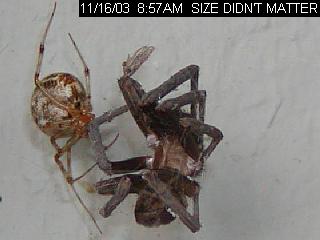 -
-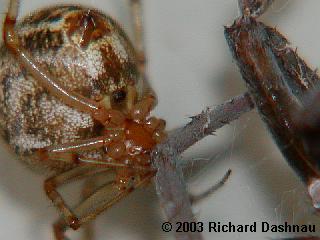 -
-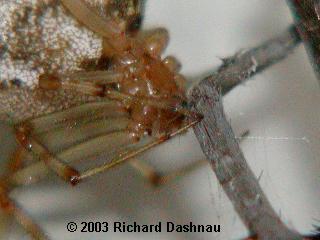 -
-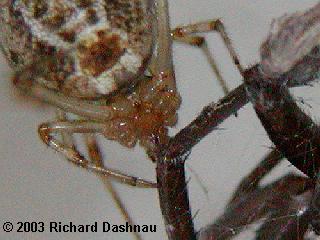 -
-
HOW
DID *THIS* HAPPEN?
EATING
01
EATING
02
EATING
03
C
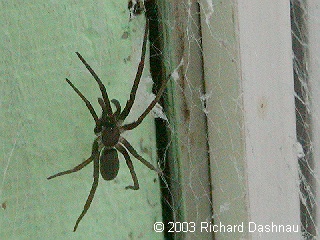
CREVICE WEAVER
The
larger spider is kind of hard to identify, but from the position
of the
legs, and by the general appearance, I'm pretty sure it's part of
that
rather large group of spiders that are sometimes known
as Aranea Mortuus---or
Dead Spider.
Update
11/19/03--Ok, I thought the dead spider thing was funny. But, I
started
wondering about what kind of spider this might actually have been
before
it became an "aranea mortuus". It's probably
the same type that we've seen
with their sparse webbing around various notholes and crevices
both inside
and outside the VC/NC at Brazos Bend State Park. Since I didn't
take any
pictures of the
dead spider's face, I'm only guessing though. I think that
I'm looking at a Southern House Spider (according to "A Field
Guide to
Spiders and Scorpions of Texas, by John A. Jackman); also
known
as Kukulcania
hibernalis (Or perhaps in this case "Kukulcania hibernalis
mortuus? HA!).
In the image "CREVICE WEAVER" above; strands of the webbing are
visible
to the right. This spider will spin
a sort of open "funnel" into a hole
or crevice, with the loose flat strands radiating out around this
hideout.
Passing prey can walk upon these tripwires, which will alert the
spider
to run out and attack. I
took this picture September of 2002, when the
spider was next to one of our windows at the VC/NC. The eyes
of this
spider are supposed to be close together, but I haven't inspected
one in
enough
detail to tell. The female is the large (13-19mm), dark one I have
pictured. The male is about half this size (9-10mm), with a
generally thinner
body that is lighter in color.
Now
that we're looking at it, why do spiders' legs curl up like that
when they
die? Well, that's pretty interesting. As in the past, I went to
the book
Biology
of Spiders, by Rainer F. Foelix, published
in 1996
for an answer. Spiders' legs, as I've mentioned before, are
composed
of seven segments. That means that there are six articulations, or
joints
between them (see LEG SEGMENTS, below).
For general body part names,
see BODY PARTS, below. Although I used the Folix book for a
reference
while I made these images, any mistakes that may be apparent are
surely
mine.
-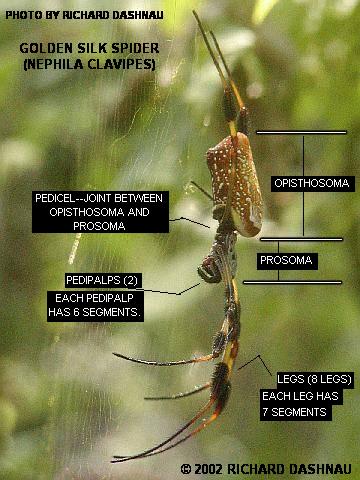 -
-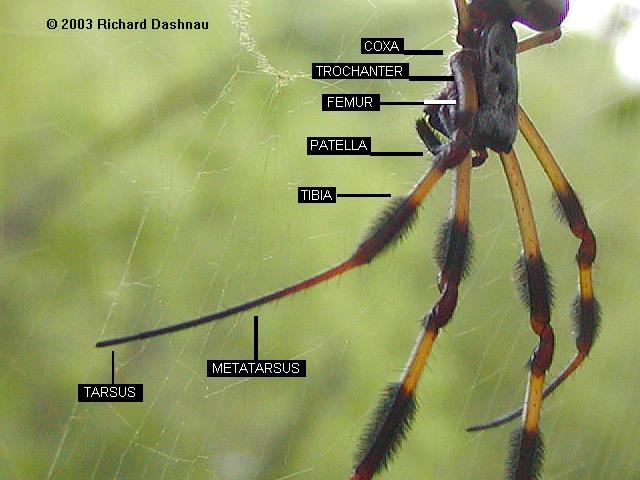 -
-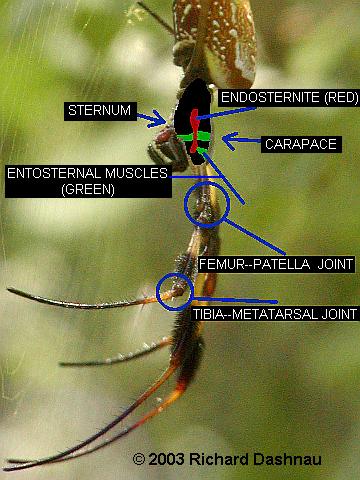
BODY
PARTS
LEG
SEGMENTS
HYDRAULIC
PUMP
Now,
most animals have two sets of opposing muscles that operate their
joints.
Flexors, which bend them, and extensors, which straighten them. In
the
spider leg, with six joints, there are two joints which
do NOT have extensor
muscles (from the tip of the leg, this is joint number 2, and
joint number
4. see HYDRAULIC PUMP, above). That means that there are no
muscles to
straighten those joints! How
then, can the spider straighten its legs?
While
you take a moment to wonder about that, consider that spiders not
only
possess an exoskeleton (the "armor"), but they also have a sort of
endoskeleton,
or inner structural supports as well. They are called
"endosterna". These
serve as attachment points for certain muscle groups (entosternal
muscles).
Largest
of the structures of this endoskeleton is shallow cuplike
construction
that sort of bisects the cephalothorax (prosoma) horizontally.
This is
called the "endosternite". There are groups of muscles
that attach this
structure to the carapace (upper surface) and sternum (lower
surface)
of the prosoma. The picture I made above shows these in VERY
simplified
form. If you are interested, find the book
and look at the professional
version. These muscles can move the endosternite, which can
lower
the volume inside the cephalothorax. Doing this can increase the
fluid
pressure inside the spider. This
is similar to you squeezing a toothpaste
tube which lowers the volume, which increases the pressure, and
forces
the toothpaste out . This increase in fluid pressure acts
like a
hydraulic pump; and this is
what extends the second and fourth leg joints.
Without the pressure the legs will fold, if the muscles contract,
and stay
folded.
While
this seems like an odd arrangement to me, spiders were here
long
before
I was, so glitches in the design must have been worked out by
now.
Pretty complicated creatures...these "simple", "primitive"
spiders.
November
23, 2003Occasionally,
I am able to find the creature I wanted to see, and take photos of
it.
Today was such an occassion. A cold front was due to hit the park
around
noon today, dropping the
temperature at least 20 degrees (that's from around
70F to 50F for you northerners), with more severe drops overnight.
I'd
hoped to be able to find a few spiders before they were possibly
killed
by a freeze.
My target today was the Southern House Spider (Kukulcania
hibernalis), which has webs all over the VC/NC--both inside and
outside
the building. I found a willing subject in our Volunteer Lounge.
-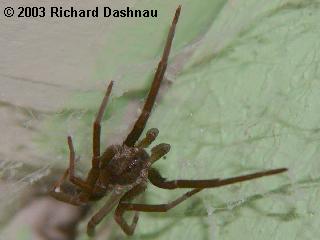 ---
---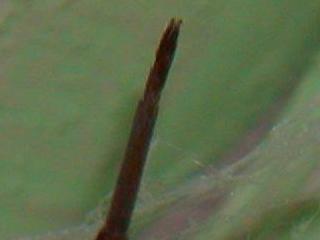 ---
---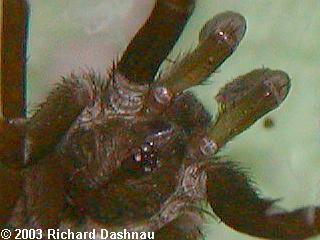 ---
---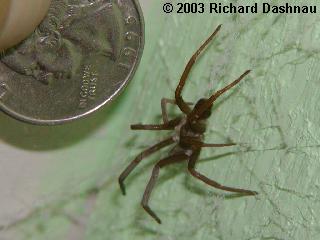
WHO'S
OUT HERE?
LEFT FRONT
LEG
HER CHARMING
FACE
HER
SIZE
She
was poised outside her hole, but when I turned on the lights. she
went
inside. Some gentle probing persuaded her to come back out, and I
took
a lot of pictures. The picture below (STRETCHED
OUT) shows a good full-body
picture, as she started moving back towards her funnel. WHO'S OUT
THERE
(above) shows her coming out of the hole. Note the widely-spaced
web strands,
and the loose
funnel of her home that is visible in some of these images
(and the clips). The next image, LEFT FRONT (above) shows a closer
view
of the left leg in the first image. The two claws at the end of
the leg
are visible. HER CHARMING FACE (above) shows the long pedipalps
(appendages
in front of the head), and the eyes arranged in a close group. The
whiteness
of some of the eyes is due to reflection
from the camera flash. When possible,
I like to show something with the spider for scale, and HER SIZE
(above)
shows her with a quarter. Through all of this, she was very
cooperative.
The sunken condition
of her abdomen probably shows that she hasn't eaten
for a while, though. I took a view short clips with the
digital camera,
also. The images below are a single frame from each clip, and
clicking
the image
will show the clip. The first one (CHECKING THE WEB) shows her
pulling on the strands of the web. The second one (GOING BACK
HOME) shows
her as she decides she's had enough photography. I
was using a flashlight
for illumination so the lighting shifts a lot.
------------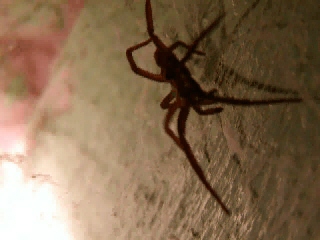 -----------
-----------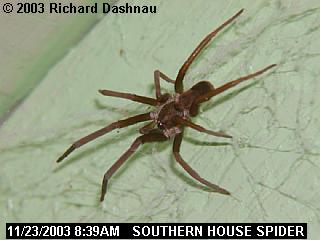 ---------------
---------------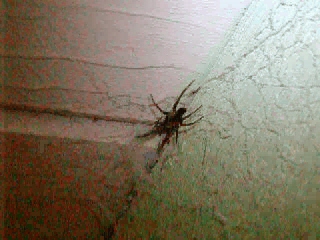 ------
------
--------- CHECKING
THE WEB (flv video 329 kb)
STRETCHED OUT
GOING BACK HOME (flv video 253 kb)
March
07, 2004
The image below (THEY SING) shows a cluster of baby spiders. They
appeared
to come from an egg case which I'd assumed belonged to my favorite
spider,
the Golden Silk Spider--
Nephila Clavipes. But, I'm not so sure, judging
by the bulbous abdomen that they show. The image below (AREN'T
THEY CUTE?)
is a close-up of some of these spiders, while the image below
(JUST
HAVE
TO PET THEM) is an image from a short video
clip
(flv video 218 kb) of them responding to my finger. Isn't it
interesting
how they move in unison? It's hard to focus on such a mass of
small objects,
and I was reluctant to separate any from the stack, so I don't
have a very
good image of a single spider.
------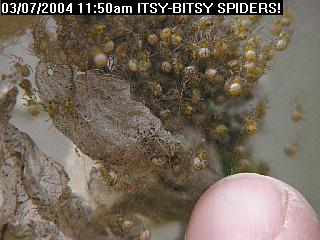 --
--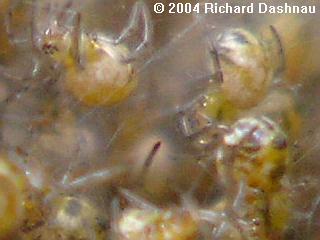 ---
---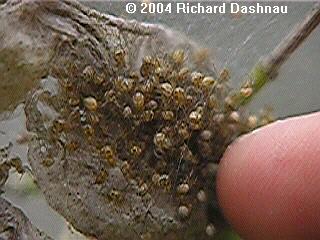 -
-
THEY SING ABOUT
THESE?
AREN'T THEY
CUTE?
JUST HAVE TO PET THEM
December
12, 2004Later
that afternoon, I went to the VC/NC for a while. While I was
there, I decided
to try to get pictures of our tarantula. According to my Field
Guide to
Spiders and Scorpions of Texas,
by John A. Jackman, the tarantulas are
in the genus Aphonopelma and there are 14 species that
are difficult
to tell apart. So, I'll just go with "tarantula".
I'm
trying to put together a presentation about spiders,
and thought some closeups
of a tarantula, which is normally considered a "primitive" spider
would
be good to contrast with other, more common types. Also, I
figured
it was about time to handle that particular
spider, since I hadn't before.
Unfortunately,
the lighting in the VC/NC and perhaps the fuzziness of the
spider's outline
made it difficult to focus my camera--especially since I was
holding the
spider in my other
hand.
She
(she's a number of years old, and therefore must be female, since
male
tarantulas don't live that long), was content to stay on her piece
of bark
at first (see RESTING, below). As I held her bark
quietly, from time to
time, she'd take a few tentative steps onto my hand. She seemed to
be uncomfortable
with the texture of my skin ("eww...it's...NOT HAIRY!") and would
step
on, then step back off. Finally,
she decided to walk onto my hand (it took
at least 10 minutes). Once she started walking, she kept on,
though.
(see I CAN WALK ON THIS below, or this short video
clip,
692 kb). So, for a while, I let her walk
up one arm, onto
my right hand, then back onto left hand and back up my arm. I
thought I
detected a slight hesitation when she first encountered my arm
hairs (see
EWW!, THIS ARM IS...HAIRY, below, or this
short video
clip,
459 kb).
While
this was going on, from time to time I'd grab my camera and take a
picture,
but only got a few usable ones, (see WRIST WATCHING and GIVE ME 5,
below).
Finally, I put her
back into her cage, where she immediately rested. I
liked
our
little encounter. I hope she did.
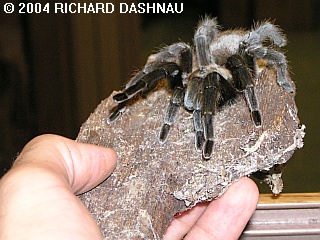 -
-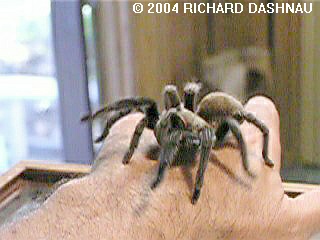 -
-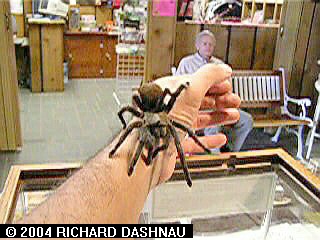 -
-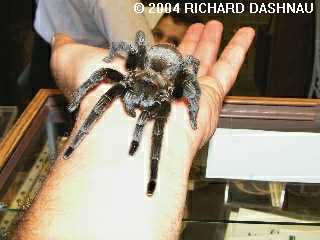 -
-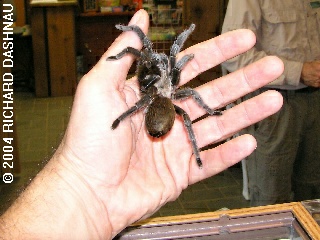
RESTING
I CAN WALK ON THIS!
EWW!, THIS ARM
IS...HAIRY
WRIST
WATCHING
GIVE ME FIVE...ER...EIGHT
video
clip 692 kb
video
clip 459 kb
4/14/2006--Well,
another
Easter at BBSP. When I walked into the VC this morning, there was
lots of talk about a mysterious spider on one of the benches on
the deck.
At first glance, it looked like some kind
of bird's poop. Well it
DID, don't give me that look. Anyway, when I saw it, I guessed
that it
was a Bolas Spider--only because I'd thought something else
looked
like one last year, and I looked at lots of pictures
of them then. It was
just a lucky coincidence that this one happened along. Chuck
Duplant pointed
out an egg case that belonged to it.
Then,
Chuck and I went into our VC library and searched through
everything we
could find for a picture of a bolas spider. No dice, until a look
in
the
"Biology of Spiders" (by Foelix) book gave us the scientific name
"mastophora"
(it's on page 147, with a picture on page 171). AHA! Then, Chuck
got
on the internet while I got some more pictures in the books in our
library.
We're pretty sure that it is indeed a Bolas Spider.
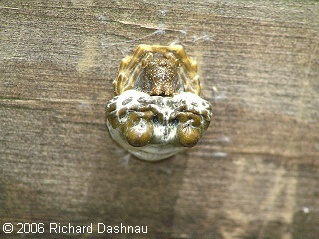 -
-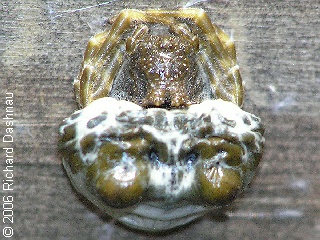 -
-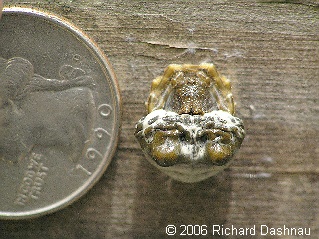 -
-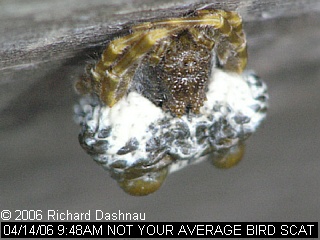
WHAT'S
THAT WHITE STUFF?
BETTER CLOSEUP
VIEW
BOLAS SPIDER AND QUARTER
BOLAS CLOSE FACE
VIEW
I got
excited about this because the mastophora is another one of those
spiders
that uses webbing (and chemical bait!) in a unique way (as
opposed
to making a snare from an orb web or "cobweb".). It emits
pheremones
that
males of a certain species of moth (Spodoptera) find
attractive.
This brings the moths near the spider. Meanwhile, the spider
extrudes a
single strand of silk with a sticky blob on the end. When insects
start
flying nearby,
it hangs down and slings this blob around in circles
(looking like one of those gouchos slinging a bolo--except with 4
more
limbs) until it hits--and sticks to--a moth. Then it reels in the
moth
and has a meal. These
spider
average about 3 moths per night. (--see Foelix, page 171.) The
spider
is nocturnal, so I didn't have much chance of seeing it in action.
So,
I looked for a video clip.
I looked
all over the internet but couldn't find a video clip
of the spider in action.
So...I made one. Actually, I pulled the clip out of a short film
that
resides
in the public domain. I cut this out, and recoded it as small as I
could
make it. Here's the link to my clip:
BOLAS 04/17/06 WMV 2660MB
The
images below are frames from the clip. Unfortunately, the spider
is fed
a moth by using a set of tweezers, so we don't get to see the
slinging
of the bolas.
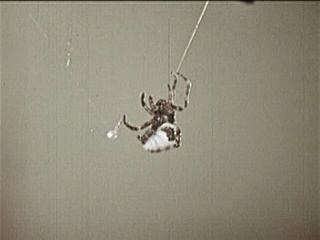 -
-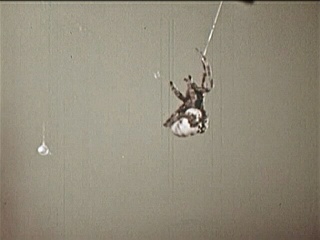 -
-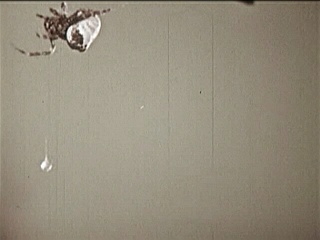 -
-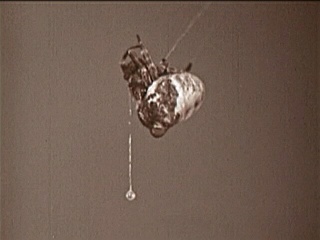 -
-
MAKING THE
BALL
LET OUT THE
LINE
GO GRAB THE
END
READY TO SLING
The name
of the original film is "Spider Engineers", 1956. At that time,
the pheromone
discovery hadn't been made yet, so the original film clip
indicates the
baiting mechanism is unknown. I've edited in a short note
telling about
the pheremone discovery. This editing of the original public
domain
material gives me ownership of the new video clip.
The entire
short film can be found on the internet archive site, and anyone
may
download
it for free, and use it however they like. That is the only reason
I'm
using it here. Since the film is in the public domain,
it is
possible to edit and update the film (especially if one doesn't
agree with
some of
the points in the film) and present it in the updated version.
Thus, the film becomes a different work.
Here's
a link to the film: http://www.archive.org/details/SpiderEngine
It's downloadable in a number of different formats
and sizes, but pay attention
to those details. The files are pretty big.
If you'd like to
know more about the park follow these links:
Brazos
Bend State Park
The main page.
Brazos
Bend State Park Volunteer's Page
The
volunteer's main page.
Click
on this image 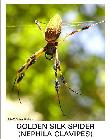 to see a flv video movie (942kb) of a series of 9 11 x 14
posters
I'm working on.
to see a flv video movie (942kb) of a series of 9 11 x 14
posters
I'm working on.
Go
back to my home page, Welcome
to rickubis.com
Go
back
to the RICKUBISCAM
page.
Go
back
to the See the
World
page.
 -
- -
- -
- -
-



























